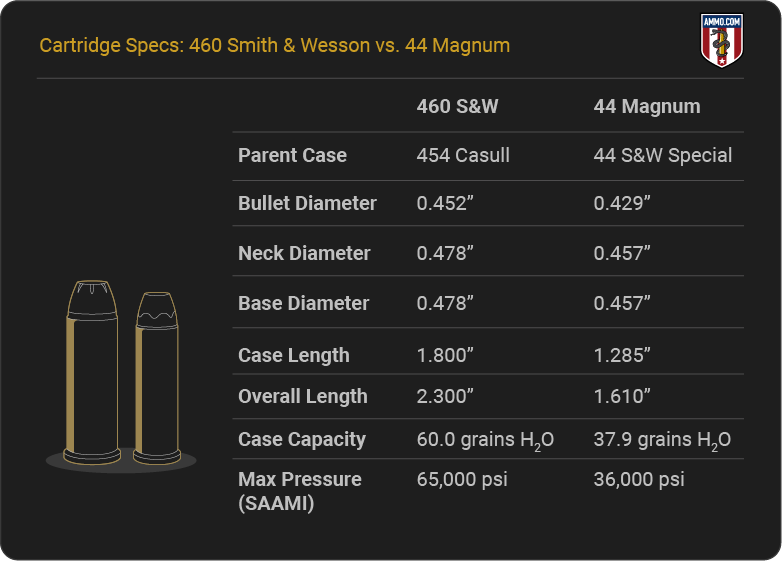The 460 Smith & Wesson Magnum and 44 Remington Magnum are both powerful handgun cartridges – but which is better for target shooting, self-defense, and hunting?
In this 460 S&W vs. 44 Mag comparison, let’s pit these two magnum handgun cartridges against one another in real-world situations, such as the amount of recoil, stopping power, and overall cost, to help you determine which is better for your situation.
Differences Between 460 S&W & 44 Mag
Though they’re both magnum cartridges often chambered in revolvers, it doesn’t mean they are identical. In fact, we’ll soon see the drastic differences in cartridge specifications and how those differences determine how each performs in various shooting scenarios.
Cartridge Specs
The legendary Elmer Keith created the 44 Magnum many decades ago based on the 44 S&W Special; it features a 0.429” diameter bullet, 0.457” case neck and base diameter, and 1.285” long case with 37.9 grains H2O capacity.
The 460 S&W was created just a couple of decades ago based on the 454 Casull; it features a 0.452” diameter bullet, 0.478” case neck and base diameter, and 1.8” long case (the 460 S&W’s case alone is 0.19” longer than the entire 44 Mag cartridge, the latter of which has an overall length of 1.61”). The 460 S&W’s overall length is 2.3”. Its case capacity is 60 grains H2O.
The disparity between the two rounds’ maximum chamber pressures is immense. The 44 Mag is no pantywaist at 36,000 psi – but at 65,000 psi, the 44 S&W is 1986 Mike Tyson.
Now, let’s see how these differences affect real-world performance, beginning with recoil.
Recoil: 460 Smith & Wesson Magnum vs. 44 Remington Magnum
When comparing two cartridges, it’s prudent to begin with their recoil. The round that kicks harder will cause sharper muzzle flip, which can lead to less accurate follow-up shots as a result. Strong kick can also worsen accuracy by causing the shooter to flinch (i.e., reflexively jerk their firearm off target in anticipation of recoil).
Neither of these rounds is known for its lack of recoil. Dirty Harry wouldn’t still be considered the pinnacle of cool if his preferred revolver were weak, and the 460 S&W is way more powerful than the 44 Mag. But how do these rounds’ recoil compare, objectively?
We won’t consider how much recoil shooters typically feel while firing these rounds. Such experiences are subjective: just as immeasurable as they are incomparable. Rather than felt recoil, let us focus on “free recoil.” It is the product of exactly four variables: projectile weight, propellant weight, muzzle velocity, and firearm weight.
When a 260 grain 460 S&W bullet achieves 1,590 fps muzzle velocity from a 4.5-pound firearm, free recoil equals 20 ft-lbs of energy. However, when firing a 250 grain bullet at 1,400 fps from the same firearm, recoil energy drops to 12.8 ft-lbs.
When a 240 grain 44 Mag bullet achieves 1,200 fps muzzle velocity from a 3.5-pound revolver, recoil equals 18.5 ft-lbs. Recoil varies a great deal depending on the aforementioned factors. Bearing that in mind, the 460 S&W typically generates more recoil than the 44 Mag, even when fired from a heavier firearm.
The 44 Mag, therefore, wins this section.
Trajectory
A bullet’s trajectory quantifies its flight path as it travels downrange. It is often measured in inches of bullet drop. When it traces the path from the muzzle to a close-range target, a trajectory resembles a flat line. At long range, a trajectory resembles an arch, as the bullet must rise and fall as it accommodates the unrelenting effect of gravity.
The flatter a cartridge’s trajectory, the easier long-range shooting becomes. A flatter trajectory requires the shooter to make fewer adjustments to their aim – primarily by making less compensation for bullet drop.
Different cartridges have different trajectories. While there are exceptions to the rule, the 460 S&W typically produces the flatter trajectory. If sighted in at 25 yards, a 360 grain 460 S&W bullet with 1,600 fps muzzle velocity will drop only -3.66” at 100 yards. Under the same circumstances, a 180 grain 44 Mag bullet with 1,500 fps muzzle velocity will drop -5.3”.
Neither cartridge is intended for long-range shooting. Even so, we can’t deny the 460 S&W’s victory in this section.
Continue reading 460 S&W vs. 44 Mag: Which Is the Better Heavy Hitting Handgun Cartridge? on Ammo.com

